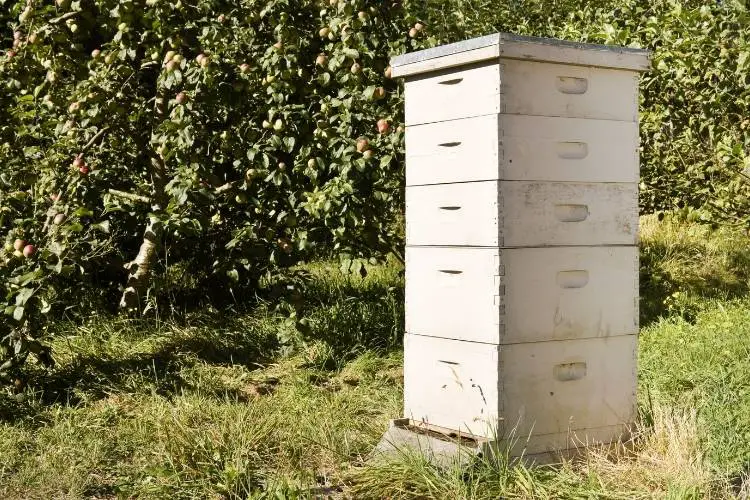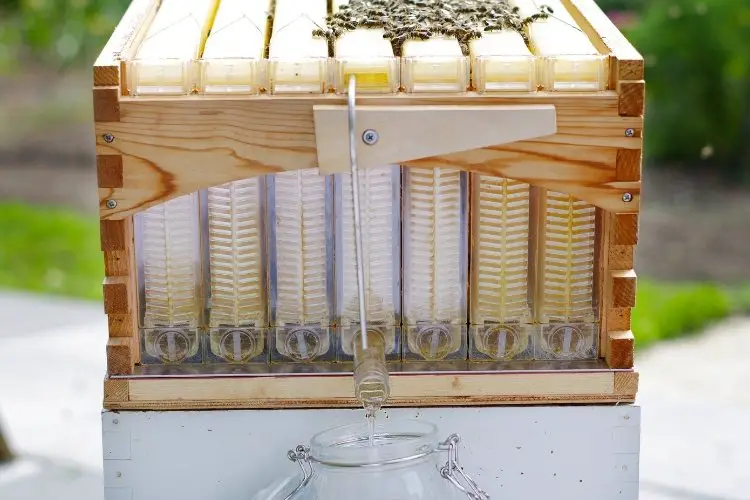If you’re thinking about becoming a beekeeper, one of the early decisions you’ll have to make is what sort of hive you choose.
Two hives that are both suitable for your backyard are the increasingly popular Flow hive, and the Langstroth hive, which is sometimes referred to as a ‘normal’ or ‘traditional’ hive because it’s very common in the U.S.
Both the Flow hive and Langstroth are vertical beehives, which means the boxes or ‘supers’ are stacked vertically when more space is needed.
The Langstroth and Flow Hive are similar in size and look similar from the outside. However, when you take a closer look, you will find they are quite different.
Which one you choose depends on your needs, your situation and also your budget.
The Langstroth Hive
Probably the most commonly used vertical beehive is the Langstroth beehive, named after its American inventor, Reverend Lorenzo Langstroth who patented it in 1852.
The Langstroth is a modular beehive, made up of individual oblong timber boxes stacked vertically, one on top of another. Each hive needs a lid and removable base.
Each box in a Langstroth hive is referred to as either a brood box or honey super, depending on what it is used for. The bottom box is usually called the brood box because it houses the queen and the brood. All of the above boxes are referred to as supers or honey supers because they typically contain honey.
The boxes come in different depths, ranging from ‘full depth’ to the shallower ‘ideal’.
In the U.S. a full depth box is referred to as a ‘deep’. Usually, the full depth box is used as the brood box, because it has the most room for the queen to lay eggs or brood.
The boxes above become the honey boxes or supers and can be full depth or shallower.

The size of super you choose can depend upon your age and strength. A full-depth honey super that is full of capped honey is incredibly heavy (sometimes up to 40kg or 90lb). You can choose to use the shallower supers as your honey supers as they won’t be so heavy to lift.
Inside each box are removable frames. The number of frames in each box will either be eight or ten, depending on what hive size you choose and they are made to fit snugly inside.
Each frame has strands of fine taught wire across them to support the wax sheet, which is gently melted onto the wire to keep it in place.
Whether you choose an eight or ten-frame hive you should, for practical reasons, stay with your initial choice and use the same size box for all your future hives. By doing this you will find you can rearrange the boxes in your apiary (bee yard).
The Flow Hive
The Flow hive is an Australian invention, released in 2015 by Cedar Anderson and his father Stuart. It’s the same shape and size as the Langstroth, but with some modifications to the design to make extracting honey easier for both you and the bees.
The Flow hive is also a modular beehive, with the boxes stacked vertically. Each one has a removable base and lid. The lid is gabled.
The bottom box that sits on the base is the brood box. It houses the queen and the brood and is full depth to allow the maximum room for the queen to lay eggs.
The Flow hive brood box fits eight frames snugly. The frames of the brood box have no wire or wax, instead they have a starter strip along the top of the frame which the bees use to build wax vertically. The bees build the comb according to their needs.
The honey super is full depth in size and the original design contains six plastic Flow frames. Other designs have been added since it was first invented, including hybrid versions using a combination of three plastic and three wax frames in the honey super. I bought my Flow hive in 2016, so it’s the original design of six plastic Flow frames.
The honey super has two observation windows, one on the side and one on the back, so that you can see how the bees are going with gathering nectar and whether or not it’s time to harvest. Each window has a removable cover.
On the back of the super just below the lid is another window with a removable cover which is where you insert the key to open the Flow frames.
Each side of the frame has partially formed cells which the bees fill with nectar and cap when the honey is ripe. The cells are angled slightly towards the center of the frame.
When the frame is ready to be harvested, a special key is inserted at the top and turned to split the cells to release the honey. The angle of each cell allows the honey to empty into a channel that is in the center of each frame.
The honey flows down and out of the bottom of the channel, through an inserted tube and into your container.

The Flow hive allows honey to be harvested without removing the lid or any of the frames so there is minimal disturbance to the bees and no messy extracting to be done.
The Pros And Cons Of A Flow Hive Vs A Langstroth Hive
I have both the Langstroth hive and the Flow hive and there are features of both that I like.
My Flow hive is the original design released in 2015. Since then, the designers have made modifications and improvements and released other types of Flow hives to cater to the different requirements of beekeepers.
What I like about the Flow hive are the observation windows. They allow you to look into your hive without disturbing the bees, which is awesome especially when you’re a new beekeeper. You can look inside every day if you wish! You don’t have to wear protective gear or use a smoker to open the hive and see inside.
However, with the Flow hive you still have to remove the honey super to inspect the brood box, and because it’s full sized it’s quite heavy and awkward for me as I’m not very tall. When it comes to inspecting the brood box, I prefer the Langstroth hive because you have the choice of shallower boxes which aren’t as heavy to move around.
Where the Flow hive stands out is harvesting time. You don’t have to open up the hive and remove any frames or disturb the bees in any way. You only look through the observation window to determine whether the frame is ready to be harvested. Once it is, you insert the key at the top to release the honey.
Also, there is no mess to clean up because the frames remain inside the hive and the bees do the work. You only have to reset the cells so the bees can start filling them again.
I found the bees more readily use wax sheet found in a Langstroth hive to build comb, rather than the plastic cells of the Flow Hive. My bees do use the plastic cells but it took them a lot longer to start using them. However, the bees use them more readily now because they have the residual honey smell from previous use.
Main Differences Between A Flow Hive And Langstroth Hive
Deciding which hive to choose really depends on your individual preference and situation. It’s not a matter of saying one is better than the other, as each has its pros and cons.
This table outlines the main differences between the Flow hive and Langstroth hive:
| Langstroth Hive | Flow Hive |
| The most popular type of hive and therefore parts and materials are readily available. | Not as common as the Langstroth hive so it’s harder to find one. |
| Easy to assemble. | Takes longer to put together. |
| Low cost. | It’s expensive to buy initially. |
| Bees store nectar in wax cells they build themselves. | Nectar is stored in partially constructed plastic cells, which bees can sometimes be reluctant to use. |
| The hive has to be opened up and inspected to determine if there is capped honey to be extracted. | Flow frames ready for harvesting can be seen through the observation window without opening the hive. |
| Parts such as supers are inexpensive. | Parts can be expensive. |
| To extract honey, frames need to be removed. | Frames of honey ready for harvest can be left inside during extraction. |
Flow Hive Vs Traditional Hive – The Final Verdict
So if you are deciding whether to buy a Langstroth hive or a Flow hive, keep in mind your individual situation. Do more research to ensure you are completely informed to make the best choice.
It’s also a good idea to ask local beekeepers or beekeeping club what type of beehives are commonly used in your area. That way, if you need help, you’ll have someone familiar with the type of hive you’re using.
I have both a Flow hive and a Langstroth hive, but if I had to choose just one I would go for the Langstroth. It’s the most common type of beehive where I live in Australia, and resources and equipment are widely available. This also makes it easy to find solutions to any problems I encounter along the way, whether that be online, in books, or via other beekeepers.
